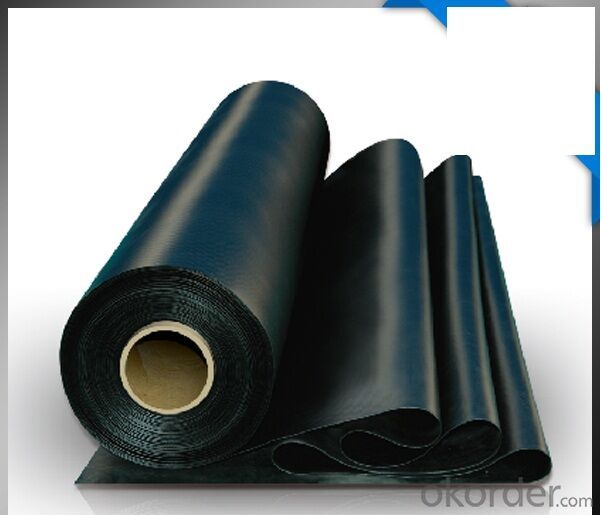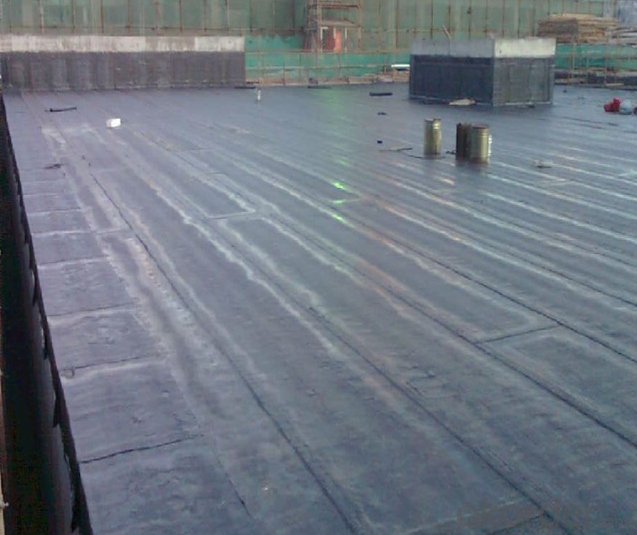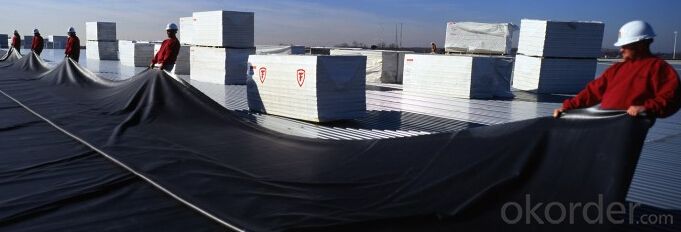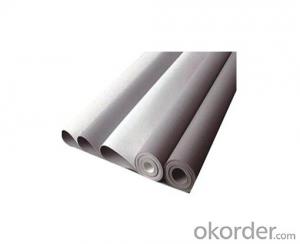Pondguard EPDM Waterproof Membrane with 2m 4m Width
- Loading Port:
- Qingdao
- Payment Terms:
- TT or LC
- Min Order Qty:
- 1000 m²
- Supply Capability:
- 100000 m²/month
OKorder Service Pledge
OKorder Financial Service
You Might Also Like
EPDM Coiled Rubber Waterproof Membrane for Ponds
Description for EPDM Rubber Waterproof Membrane :
GeoGard EPDM offers dependable performance for irrigation reservoirs, canals, aquaculture, dung pits, landfill covers,
waste water reservoirs, constructed wetlands, artificial snow reservoirs, storm water reservoirs, fire reservoirs and
large decorative ponds.
Main Features of EPDM Rubber Waterproof Membrane:
Artificial lakes
Golf course water features
Commercial decorative ponds
Residential decorative ponds
Reflection ponds
Streams, waterfalls and fountains
Swimming ponds
Natural swimming pools
Leisure park water features
Specifications of EPDM Rubber Waterproof Membrane:
Material | EPDM Rubber |
Size | 1.2m (width)*20m (length) or customized, weldable type 2.05m or 4m width |
Thick | 1.2mm, 1.5mm, 2.0mm |
Type | Vulcanized & Weldable |
Pattern | Non-reinforced (homogeneous) |
Certificate | ISO9001/14001 |
Training
The RubberGard EPDM Roofing System is exclusively installed by approved roofing contractors that have successfully completed a training program in one of training centers.EPDM Project References
Operating since 3 decades in Europe and Asia, our Products has installed hundreds of thousands of EPDM roofs. The project portfolio includes a selection of major projects.
Images of EPDM Rubber Waterproof Membrane:





FAQ:
1. What are we supplying?
We are specialized in producing Colorful Asphalt Roof Shingle, SBS/APP modified bitumen waterproof membrane, Self adhesive bitumen waterproof membrane, PVC waterproofing membrane, EPDM rubber roofing membrane, Single Component Polyurethane Waterproof Coating, and Spray Polyurea Waterproof Coating
.
2. How Many years experience do we have?
We have been exported to more than 20 countries in the past 15 years.
3. How long do we usually reply your request?
We always reply our customer within 24 hours.
- Q: Can a waterproofing membrane be used on stainless steel surfaces?
- Indeed, stainless steel surfaces can benefit from the application of a waterproofing membrane. Stainless steel, a resilient and non-corrosive material widely utilized across different industries, is not impervious to water damage or corrosion, particularly in severe conditions. By applying a waterproofing membrane onto stainless steel surfaces, an extra shield against moisture is established, effectively warding off potential water damage, rusting, and corrosion. To guarantee optimal adhesion and durable protection, it is crucial to ensure the compatibility of the waterproofing membrane with stainless steel and its correct application.
- Q: Does a waterproofing membrane provide any insulating properties?
- No, a waterproofing membrane does not provide any insulating properties. Its primary function is to prevent water penetration and protect the underlying structure from moisture damage.
- Q: Can a waterproofing membrane be used in swimming pools or other water features?
- Certainly, swimming pools or other water features can indeed utilize a waterproofing membrane. In fact, it is highly advisable to employ such a membrane in these areas to avert water leakage and potential harm. By serving as a barrier between the water and the surrounding structures, a waterproofing membrane ensures that the water remains contained within the pool or water feature. Not only does it prevent water seepage, which can inflict structural damage and necessitate expensive repairs, but it also safeguards the pool or water feature from the harsh chemicals employed for water treatment, thereby guaranteeing its durability and long lifespan. Consequently, the utilization of a waterproofing membrane is an essential measure in the construction or renovation of swimming pools or other water features, guaranteeing their functionality and longevity.
- Q: Can a waterproofing membrane be installed in wet conditions?
- Yes, a waterproofing membrane can be installed in wet conditions. However, it is important to ensure that the surface being waterproofed is dry and free of any standing water before the installation. This is because the membrane needs a clean and dry surface to adhere properly and create an effective barrier against water. If the surface is wet, it may prevent the membrane from bonding correctly, leading to potential leaks or failures in the waterproofing system. Therefore, it is recommended to wait for the surface to dry or use appropriate methods to remove any excess moisture before installing the waterproofing membrane.
- Q: Can a waterproofing membrane be used on both horizontal and vertical surfaces?
- Yes, a waterproofing membrane can be used on both horizontal and vertical surfaces. Waterproofing membranes are specifically designed to create a barrier against water infiltration, regardless of the orientation of the surface. These membranes are commonly used in various applications, such as roofs, foundations, basements, bathrooms, and swimming pools. They are typically made of materials like bitumen, rubberized asphalt, polyurethane, or PVC, which are highly resistant to water penetration. Whether it is a horizontal surface like a roof or a vertical surface like a wall, a waterproofing membrane can effectively prevent water from seeping through and causing damage. However, it is important to ensure that the membrane is properly installed and adhered to the surface to achieve optimal waterproofing performance.
- Q: Can a waterproofing membrane be used on masonry surfaces?
- Indeed, masonry surfaces can benefit from the utilization of a waterproofing membrane. Employing a waterproofing membrane on masonry surfaces is a prevalent approach to thwart water infiltration and subsequent harm. Concrete, brick, or stone masonry surfaces are permeable and have the capacity to absorb water, resulting in potential structural deterioration, growth of mold, and overall degradation over time. The purpose of a waterproofing membrane is to serve as a barrier, preventing water from permeating the masonry and safeguarding it against moisture-related predicaments. It is crucial to select a waterproofing membrane that is specifically engineered for masonry surfaces and adhere to the instructions provided by the manufacturer for appropriate application.
- Q: Can a waterproofing membrane be used on stucco surfaces?
- Yes, a waterproofing membrane can be used on stucco surfaces. Waterproofing membranes are often applied to stucco surfaces to protect them from water damage and enhance their durability. These membranes create a barrier that prevents water from seeping into the stucco, helping to maintain its integrity and preventing moisture-related issues such as cracking or mold growth.
- Q: Can a waterproofing membrane be used for shower or bathroom installations?
- Yes, a waterproofing membrane can be used for shower or bathroom installations. The membrane acts as a protective barrier, preventing water from penetrating through the walls or floor and causing damage. It is commonly used in wet areas like showers and bathrooms to ensure a waterproof seal and to maintain the integrity of the surrounding surfaces.
- Q: Can a waterproofing membrane be used for tunnels and underground structures?
- Yes, a waterproofing membrane can be used for tunnels and underground structures. Waterproofing membranes are commonly used in construction to provide a barrier against water infiltration and protect structures from potential damage caused by water. In the case of tunnels and underground structures, where there is a higher risk of water ingress due to the surrounding soil and groundwater, waterproofing membranes are essential to ensure the integrity and longevity of the infrastructure. Waterproofing membranes for tunnels and underground structures are specifically designed to withstand the unique challenges posed by these environments. They are typically made of durable and flexible materials such as bitumen, PVC, or EPDM, which can effectively resist water pressure and provide long-lasting protection. Additionally, these membranes are often reinforced with various layers or fabrics to enhance their strength and resistance to puncture or tear. The application of waterproofing membranes in tunnels and underground structures involves a meticulous process. The surfaces that need to be waterproofed, such as the walls and floors, are thoroughly cleaned and prepared to ensure proper adhesion of the membrane. The membrane is then applied in multiple layers, ensuring complete coverage and a seamless seal. Special attention is given to critical areas such as joints, corners, and penetrations to prevent any potential weak points. By using a waterproofing membrane, tunnels and underground structures can be effectively protected from water intrusion, groundwater pressure, and potential damage caused by moisture. This helps to maintain the structural integrity of the infrastructure, prevent water-related problems such as leaks, corrosion, or deterioration, and ensure the safety and functionality of the tunnel or underground facility.
- Q: Are waterproofing membranes resistant to hydrostatic pressure?
- Yes, waterproofing membranes are designed to be resistant to hydrostatic pressure.
Send your message to us
Pondguard EPDM Waterproof Membrane with 2m 4m Width
- Loading Port:
- Qingdao
- Payment Terms:
- TT or LC
- Min Order Qty:
- 1000 m²
- Supply Capability:
- 100000 m²/month
OKorder Service Pledge
OKorder Financial Service
Similar products
Hot products
Hot Searches
Related keywords


































